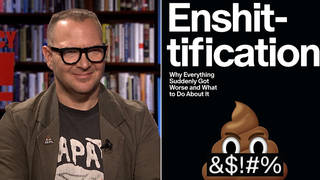
Guests
- Ian Millhisersenior fellow at the Center for American Progress Action Fund and the editor of ThinkProgress Justice. He is the author of the book, Injustices: The Supreme Court’s History of Comforting the Comfortable and Afflicting the Afflicted.
After historic rulings that legalized same-sex marriage nationwide and upheld a key provision of the Affordable Care Act, this week the Supreme Court handed down its final rulings for the current term, dealing with abortion access, air pollution, executions and elections. We examine the decisions and look at pending rulings on affirmative action and union dues with Ian Millhiser, editor of ThinkProgress Justice and author of “Injustices: The Supreme Court’s History of Comforting the Comfortable and Afflicting the Afflicted.”
Transcript
JUAN GONZÁLEZ: After historic rulings that legalized same-sex marriage nationwide and upheld a key provision of the Affordable Care Act, this week the Supreme Court handed down its final rulings for the current term, dealing with abortion access, air pollution, executions and elections. On Monday, the court blocked a lower court decision that threatened to leave Texas with fewer than 10 abortion clinics. It said clinics do not have to follow requirements forcing them to meet the standards of hospital-style surgery centers that were set to take effect today. In another decision, the court blocked the Environmental Protection Agency’s first national standards to cut emissions of mercury and toxic air pollutants from coal-fired power plants.
AMY GOODMAN: This week, the Supreme Court also rejected a challenge to the use of a controversial sedative in executions. Three Oklahoma prisoners had sought a ban on midazolam, which has been tied to several botched or prolonged lethal injections. But a five-to-four majority rejected the prisoners’ claim that the drug violates a ban on cruel and unusual punishment.
For more, we go right to Washington, D.C., to Ian Millhiser, senior fellow at the Center for American Progress Action Fund and the editor of ThinkProgress Justice, author of the book, Injustices: The Supreme Court’s History of Comforting the Comfortable and Afflicting the Afflicted.
First of all, Ian, welcome to Democracy Now! Can you, overall, assess the direction of the court, from upholding Obamacare and same-sex marriage to this series of lesser-known decisions that they issued this week, including the issue of lethal injection and the death penalty?
IAN MILLHISER: Right. So, this was a very unusual term. You know, the Roberts court is a very conservative court, and most terms I wind up pretty depressed this time of year, because they’ve just handed down a lot of conservative decisions. The good news is, for the most part, that didn’t happen this term. Obviously, we got the big marriage equality holding. There were also a lot of disasters that did not happen. They could have gutted the Affordable Care Act and sent America’s healthcare markets into turmoil; that didn’t happen. They could have gutted the Fair Housing Act, and that didn’t happen. They could have cast a bunch of state election laws into chaos, and that didn’t happen. Now, most of those were five to four; one was a six-to-three decision. So there were justices who wanted to do some pretty terrible things. But the good news is that there were a lot of crises that were averted this term, and then, of course, we had the marriage equality holding, which is a huge victory.
JUAN GONZÁLEZ: But, Ian, in terms of—there are some analyses that have said that the surprising outcome of the decisions in this term are resulting from divisions that have occurred among the conservatives, while the liberal justices have stayed pretty much united. What’s your assessment of that?
IAN MILLHISER: Yeah, no, I’m one of the analysts who has said that. I mean, what’s interesting about this court is that the four liberal justices, even though they’re in the minority, have largely stuck together. The conservatives, you know, there’s real disagreement about how far they want to take their conservatism and of their general approach to the law. You know, Roberts, Chief Justice Roberts, is a Reaganite conservatism. He wants to do a lot of very conservative things on race. He wants to do a lot of very conservative things on campaign finance. But he doesn’t embrace the kind of radicalism that you’ve seen take over the conservative movement in the United States since President Obama got elected. You know, he doesn’t believe that the court should be used to dismantle the whole regulatory and welfare state. You know, Justice Thomas is at the other extreme, where Thomas has said he would go back to the world where child labor laws are struck down. So, what I think a lot of the reason why this case didn’t go as well for conservatives as they had hoped is they really pushed the envelope this year. They acted like they had five Justice Thomases on the court, or maybe five Justice Alitos, who’s also another very conservative justice. And what happened is, Roberts and Kennedy said, “Wait a second. Like, a lot of these things that you’re asking for, that’s a bridge too far.”
AMY GOODMAN: In fact, we just interviewed a couple who were plaintiffs in the same-sex marriage case, and they are naming their daughter “Kennedy.” Now, but I want to go to the issue of the death penalty, which was so critical this week, the Supreme Court rejecting the challenge to use a controversial sedative in executions. The three Oklahoma prisoners had sought a ban on the sedative, which has been tied to several botched or prolonged lethal injections, the five-to-four majority rejecting the prisoners’ claim the drug violates a ban on cruel and unusual punishment. Last April, Oklahoma prisoner Clayton Lockett died of a massive heart attack when his lethal injection with an untested cocktail of lethal drugs was botched. After struggling violently on the gurney, doctors halted the killing 13 minutes in, when discovering Lockett was still conscious and trying to speak. About 30 minutes later, Lockett died of a heart attack when the drugs spread through his body. This is Ziva Branstetter of Tulsa World, one of the 12 media witnesses, describing what she saw.
ZIVA BRANSTETTER: So what happened is, at 6:23, the execution began. The inmate had no last words. About 10 minutes later, they pronounced him unconscious. There was no reaction for about three minutes. And then, at about—about, you know, I would say three minutes after that, he began a very violent reaction. He began writhing, lifting his shoulders up off the gurney and his head up off the gurney. He was clenching his jaw, exhaling. He was mumbling phrases that none of us could really hear. The only audible word we could hear was him saying “man.” And he appeared to be in pain, but we couldn’t understand what he was saying. This lasted for about three minutes. The physician in the execution chamber went over, lifted up the sheet, looked at his right arm. The warden of the Oklahoma State Penitentiary, who was also in the execution chamber, said that they were going to have to temporarily close the blinds. And after that, they never reopened them.
AMY GOODMAN: That’s Ziva Branstetter of the Tulsa World describing the botched execution of Oklahoma prisoner Clayton Lockett last April. Charles Warner was originally scheduled to die that same night as Lockett, but his execution was postponed until January. Then, when the state carried out his lethal injection, he took 18 minutes to die, twice as long as the average. His final words were, quote, “My body is on fire.” Can you talk, Ian Millhiser, about what the court ruled?
IAN MILLHISER: Sure. So, I mean, this case was called Glossip v. Gross, and it’s one of the big disappointments of the term. The court essentially gave superlegal status to the death penalty. You know, the way that the Constitution is supposed to work is that there’s a prohibition on cruel and unusual punishment. And so, if the state wants to carry out a punishment—if they want to execute someone, in this case—you look at the method they want to use, determine if it’s cruel or unusual. And if it is, then they can’t do it. And what the court said instead is they said that executing people is of paramount importance. They said that the death penalty was something we’ve said is constitutional, so there must be a way to execute people. And that means that—and there’s various reasons why the state wasn’t able to get other drugs that would have been more reliable. If the only methods that are available to them are drugs that are not reliable and that may lead to the inmate being in excruciating pain, then you know what? That’s what the state gets to use, because, again, the court said that, essentially, executing people is of paramount importance, and in this case it trumps the Eighth Amendment of the Constitution.
JUAN GONZÁLEZ: Ian, I’d like to ask you about some of the surprising decisions, especially when it comes to redistricting and fair housing in the Arizona redistricting case. Could you talk about those, as well?
IAN MILLHISER: Sure. And I mean, these were two—I mean, especially the fair housing case—were two of the more pleasant surprises this term. So, Chief Justice Roberts, one issue where he is extraordinarily conservative is race. You know, he has made it his mission on the court to cut back on civil rights laws. He struck down a key portion of the Voting Rights Act. You know, he’s famous for his naive line that the way to end discrimination on the basis of race is to end discrimination on the basis of race, as if that’s all there is to it.
And there was a case this term that sought to really gut the federal Fair Housing Act that bans race discrimination in housing. The law allows what’s called disparate impact suits, where you can start to prove discrimination if you show that there’s bad outcomes, where a company has a policy that continually leads to people of color getting the shaft. The court—most people thought they were going to get rid of this disparate impact litigation, which would have made it very hard to prove these cases. And Justice Kennedy blinked, so it was a five-to-four decision. The Fair Housing Act still gets to live in the form that it has lived for many years.
In addition to that, as you mentioned, there was this redistricting case, which wasn’t just about redistricting. It was a very broad theory, which, if it had succeeded, could have led to the Supreme Court taking a red pen and randomly crossing out lines in a bunch of states’ election laws. So, that was a five-to-four decision where Justice Kennedy also crossed over to join the liberals. I suspect the reason why he did is because he realized that it would just throw our next election into chaos if states didn’t know what their election law was.
AMY GOODMAN: The issue of abortion, Ian Millhiser?
IAN MILLHISER: Sure. So this came up, and I think we shouldn’t overstate what the Supreme Court did here, but it’s good news for the right to choose. So, there is a Texas law that, if it is ultimately upheld by the Supreme Court, is really an existential threat to the right to choose an abortion. This is one of a number of sham health laws where the state enacts a law which, if you look at it just on the surface, it appears to be a health regulation, but really what it is, is it’s an attempt to ban abortion by pretending that you’re regulating health. The Supreme Court, five to four, temporarily allowed that law to go into effect. This probably buys women in Texas who seek an abortion about a year. It’s likely the Supreme Court is going to take this case up and, probably in next June, decide whether or not they’re going to strike down the law. If they uphold the law, then that is terrible news for Roe v. Wade. If they uphold the law, it means that the only limit on states’ ability to restrict abortion will probably be the creativity of lawmakers to find a way to dress a wolf up in sheep’s clothing.
AMY GOODMAN: Union fees?
IAN MILLHISER: And that’s another huge case they’re deciding next term. So, the issue here is that if you are a union, you have to bargain on behalf of everyone in the bargaining unit. So everyone in the shop, regardless of whether they join the union or not, they get the higher wages you bargain for, they get the increased benefits you bargain for. And in many cases, the nonmembers also have to reimburse the union for the cost of their share of the bargaining. So no one gets to be a free rider. No one gets something for nothing. This is a case about whether non-union members in public sector unions can get something for nothing, whether they can get all the benefits, get all the higher wages, and yet not have to pay their share of the bargaining cost. If the Supreme Court says that they don’t have to pay their fair share, which I think is likely, it’s going to be a huge blow for public sector unions, because there’s a lot of workers who are going to say, “Well, why am I going to pay to join the union when I get all the benefits of being a member for nothing?”
JUAN GONZÁLEZ: I wanted to ask you about the subtitle of your book, Injustices: The Supreme Court’s History of Comforting the Comfortable and Afflicting the Afflicted. Why that subtitle, and what’s the broad strokes of your analysis on the court’s historical record?
IAN MILLHISER: Sure. I mean, the court has a dark history. I mean, this is the court that upheld segregation. It’s a court that struck down child labor laws. It’s a court that struck down the minimum wage. It’s a court that said a woman could be sterilized against her will. The modern Supreme Court, under Chief Justice Roberts, gave us Citizens United. They gutted the Voting Rights Act. You know, if you go back a few years, we get Bush v. Gore. So, you know, we had a decent term, but this was a really anomalous term, not just in terms of the Roberts court’s history, but in terms of the Supreme Court’s entire history. You know, for almost all of the Supreme Court’s history, it has been terrible to workers, terrible to women, terrible to racial minorities. And I worry that, you know, depending on what happens in the next few presidential elections, it could go back to the worst form that it was in many years ago.
AMY GOODMAN: And finally, affirmative action next term?
IAN MILLHISER: Yeah, and this is a case that they’ve heard now twice. This is a challenge to the University of Texas’s affirmative action program. It came up before the court a few years ago, and the court basically gave the program a stay of execution. They sort of upheld the program. They said that they weren’t going to strike it down yet, but they were going to send it down to the most conservative court of appeals in the country to look at it again. That court of appeals surprised everyone by upholding the program, and now it’s back in front of the Supreme Court. You know, I mean, they surprised us on the fair housing case, so I’m not going to write affirmative action off entirely, but it’s going to be a tough road for affirmative action to survive the second trip to the Supreme Court.
AMY GOODMAN: Ian Millhiser, we want to thank you for being with us, senior fellow at the Center for American Progress Action Fund, editor of ThinkProgress Justice, author of the book, Injustices: The Supreme Court’s History of Comforting the Comfortable and Afflicting the Afflicted.
This is Democracy Now! When we come back, Governor Christie makes 14. We’ll talk about the newest entrance into the Republican presidential race. Stay with us.











Media Options